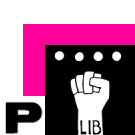User:Amy Suo Wu/Physical Media: Difference between revisions
Amy Suo Wu (talk | contribs) (Created page with "Physical Media Properties and methods of protocols: 1. TCP (Transmission Control Protocol) > Transport layer (only responsible for making sure everything arrives; data travels...") |
Amy Suo Wu (talk | contribs) No edit summary |
||
| (2 intermediate revisions by the same user not shown) | |||
| Line 1: | Line 1: | ||
Introduction of 'Protocol: How Control Exists After Decentralization' by Alexander Galloway | |||
| Line 5: | Line 5: | ||
1. TCP (Transmission Control Protocol) | 1. TCP (Transmission Control Protocol) | ||
*Transport layer (only responsible for making sure everything arrives; data travels to correct destination) | |||
*Uses the three way handshake | |||
*Creates an imaginary circuit between sender and receiver | |||
*Robust quality | |||
*Conservative and liberal. Accepts everything, but if it's corrupt will immediately delete. | |||
+ Telephone call ("opening and closing sentences to establish conversation") | + Telephone call ("opening and closing sentences to establish conversation") | ||
| Line 17: | Line 17: | ||
2. IP (Internet Protocol) | 2. IP (Internet Protocol) | ||
*Partner of TCP (together they make a protocol suite) | |||
*As the engine in the car, but doesn't know how to steer. | |||
*Responsible for routing and fragmentation | |||
ROUTING | |||
*Flexible routing system called hopping, doesn't know final destination, but knows next nearest | |||
*Makes datagram containing "expiring date" | |||
FRAGMENTATION | |||
*Gets disintegrated into small packages (called datagrams) which can be send over the network. | |||
*Packages are then reassembled to make a whole file again | |||
*Get's refragmentated to fit the network size (smaller "roads" will only allow smaller packages) | |||
+ Chinese whisper (program a hub to change data slightly) | + Chinese whisper (program a hub to change data slightly) | ||
| Line 33: | Line 35: | ||
3. TCP/IP | 3. TCP/IP | ||
*Fascilitates peer to peer communication | |||
*Distributed technology i.e. Rhizome model | |||
*Universal language | |||
*Robust flexible, strong | |||
*Open to broad variety of computers | |||
*Result of the action of autonomous agents | |||
4. DNS (domain name system) | 4. DNS (domain name system) | ||
*Translator from names to numeral (because computers read numbers more easily and humans read words better) | |||
*Predecessor was called hosts.txt, and was called namespace (centralized system) | |||
*DNS is decentralized database. | |||
*Inverted tree like structure (hieracy) | |||
*Decentralized because one layer can only talk to the next layer and not deeper layers. | |||
+ current political system (politicians trying to communicate to lower levels) | + current political system (politicians trying to communicate to lower levels) | ||
Latest revision as of 15:14, 27 October 2010
Introduction of 'Protocol: How Control Exists After Decentralization' by Alexander Galloway
Properties and methods of protocols:
1. TCP (Transmission Control Protocol)
- Transport layer (only responsible for making sure everything arrives; data travels to correct destination)
- Uses the three way handshake
- Creates an imaginary circuit between sender and receiver
- Robust quality
- Conservative and liberal. Accepts everything, but if it's corrupt will immediately delete.
+ Telephone call ("opening and closing sentences to establish conversation") + Offline meetings (would be nice if entire conversation would end with one miscommunication) + Make the circuit visible by throwing wool or rope of some sort.
2. IP (Internet Protocol)
- Partner of TCP (together they make a protocol suite)
- As the engine in the car, but doesn't know how to steer.
- Responsible for routing and fragmentation
ROUTING
- Flexible routing system called hopping, doesn't know final destination, but knows next nearest
- Makes datagram containing "expiring date"
FRAGMENTATION
- Gets disintegrated into small packages (called datagrams) which can be send over the network.
- Packages are then reassembled to make a whole file again
- Get's refragmentated to fit the network size (smaller "roads" will only allow smaller packages)
+ Chinese whisper (program a hub to change data slightly) + fragmentation reminds of of IKEA + Datagram looking where to go
3. TCP/IP
- Fascilitates peer to peer communication
- Distributed technology i.e. Rhizome model
- Universal language
- Robust flexible, strong
- Open to broad variety of computers
- Result of the action of autonomous agents
4. DNS (domain name system)
- Translator from names to numeral (because computers read numbers more easily and humans read words better)
- Predecessor was called hosts.txt, and was called namespace (centralized system)
- DNS is decentralized database.
- Inverted tree like structure (hieracy)
- Decentralized because one layer can only talk to the next layer and not deeper layers.
+ current political system (politicians trying to communicate to lower levels) + institution + cross reference (for one document you need another document)
Question: where does DNS live?
